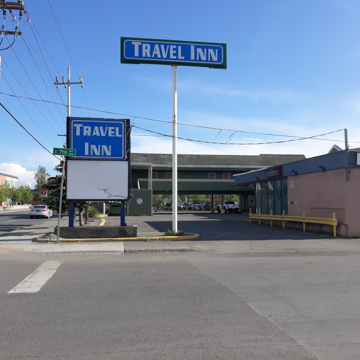You are here
Travel Inn
The Traveler’s Inn, completed in 1953, was the first hotel built by the developer and eventual governor, Wally Hickel. Construction began in 1952 and cost $400,000 (roughly $3.8 million in 2020). The hotel marked the outer rim of Anchorage's downtown and displaced a mink farm. Built close to the Seward Highway (Alaska Highway 1), a key north-south route through Southcentral Alaska's population centers, it was a prime location for motorists traveling through the area. At the time, West Coast Builders magazine declared the Inn the finest establishment of its kind in the West. Following the success of the Anchorage location, Hickel developed a Fairbanks location in 1955.
Typical of postwar motor lodges, the Traveler's Inn was two stories and its U-shaped plan is organized around a central parking lot. The ground-level rooms open up to the parking lot while those on the second-floor open onto an elevated walkway that doubles as a balcony. The hotel office is located adjacent to the entrance drive and effectively closes off to the public the rooms around the perimeter of the parking lot.
In a time before hotel chains became part of the Anchorage landscape, the Traveler’s Inn was one of the city’s higher-end travel lodges. At $9 a night originally (about $85 in 2019), the cost was high for Anchorage. But, said Hickel, “people stayed at the Traveler’s because we offered food and liquor on the premises.” In 1953, the Kobuk, the onsite restaurant for the lodge located at the corner of 7th and Gambell, offered New York cut steak for $5.50 (about $53 in 2019), coffee for 15 cents (about $1.50 in 2019), pie for 40 cents (about $4 in 2019). However, an order of fruit salad cost $2.25, or almost $22 in 2019 dollars. Fresh fruit was much more difficult to obtain in early 1950s Anchorage. The menu at the Kobuk thus provides a glimpse into the challenges of obtaining fresh fruits and vegetables in mid-twentieth-century Alaska, before the era of big-box stores. The cocktail bar, among the fanciest spots in Anchorage for the time, conveyed a midcentury aesthetic and drew locals and tourists alike. With its wood panel walls, leather seating, and carved wooden screens dividing the room, patrons could imbibe at the semicircular bar or table seating.
The hotel was “part of the family” to Hickel. After his home neighborhood of Turnagain-by-the-Sea was uninhabitable after the 1964 Good Friday earthquake, the Hickel family resided at the Inn. Originally constructed with fifty-two rooms, the hotel was expanded during the 1960s to seventy rooms. Hickel sold the hotel to Anchorage hotelier Bruce Kendall in 1982. That year, Kendall renamed the hotel the Samovar Inn. More recent ownership renamed the hotel the Travel Inn. Today it does not enjoy the same exalted opinion among Alaskans. It is generally regarded as a budget option and has gained a reputation for crime and vice.
References
“2 Hotels Change Management.” Anchorage Daily Times, May 14, 1982, B8.
“52-Unit Motel Built for over $400,000.” Anchorage Daily Times, October 11, 1954, 29.
“Chef Feted for 25 Years.” Anchorage Times, September 28 , 1980, D3.
“Motel-Hotel Work Increases.” Anchorage Daily Times, July 31, 1963, 5.
Tobin, William J. “Saturday Sundry.” Anchorage Times, July 24, 1982, B1.
“Traveler’s Inn Rates Best on Entire West Coast.” Anchorage Daily Times, October 11, 1954, 29.
Writing Credits
If SAH Archipedia has been useful to you, please consider supporting it.
SAH Archipedia tells the story of the United States through its buildings, landscapes, and cities. This freely available resource empowers the public with authoritative knowledge that deepens their understanding and appreciation of the built environment. But the Society of Architectural Historians, which created SAH Archipedia with University of Virginia Press, needs your support to maintain the high-caliber research, writing, photography, cartography, editing, design, and programming that make SAH Archipedia a trusted online resource available to all who value the history of place, heritage tourism, and learning.




















